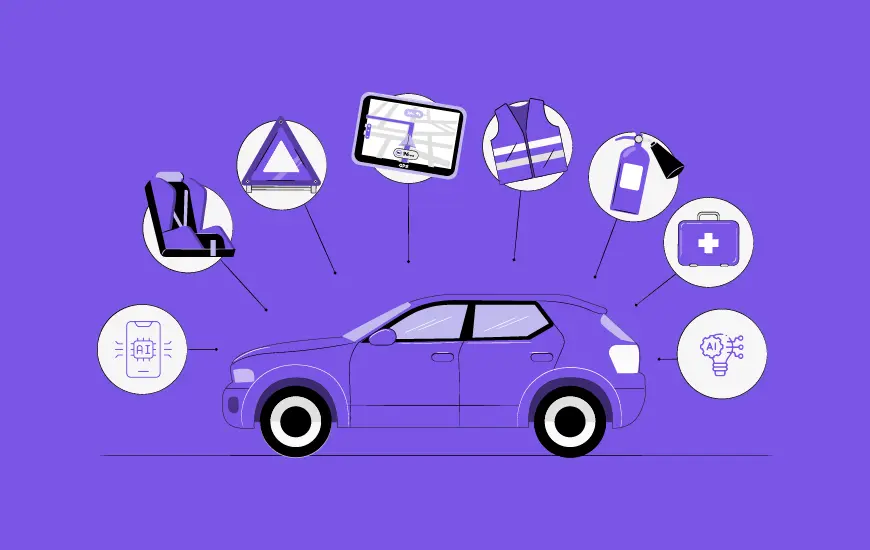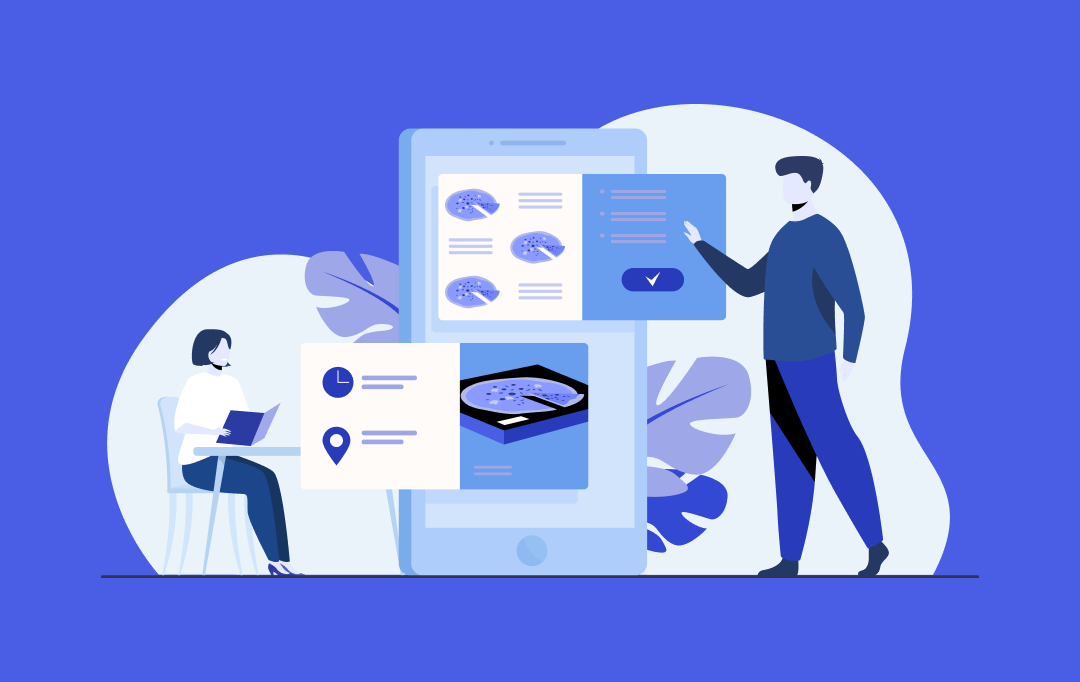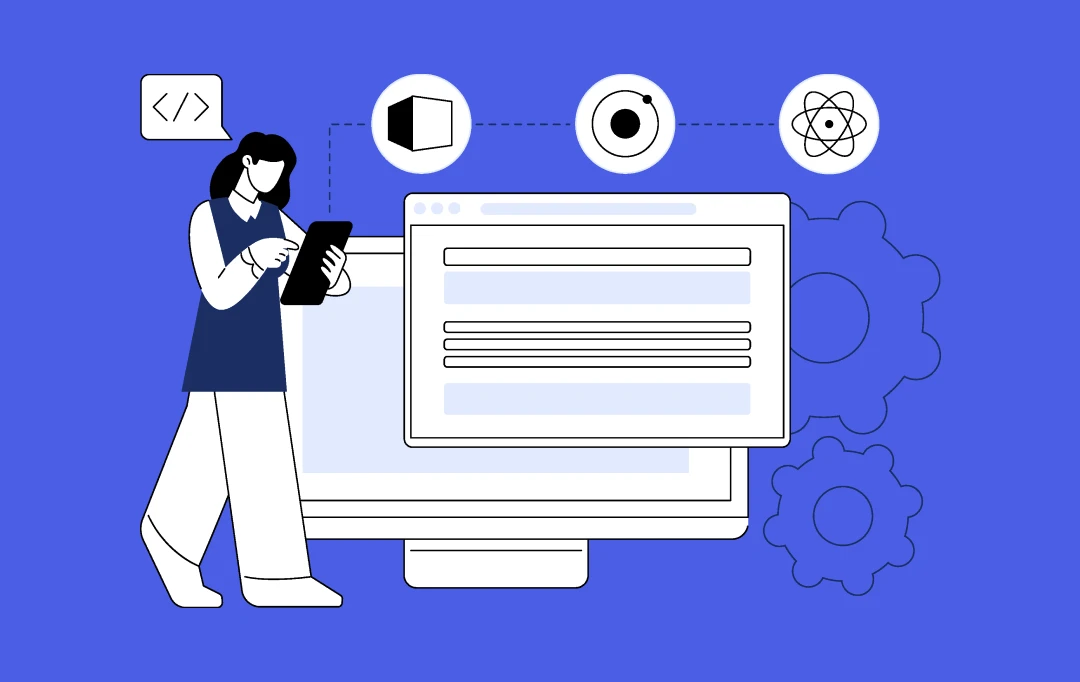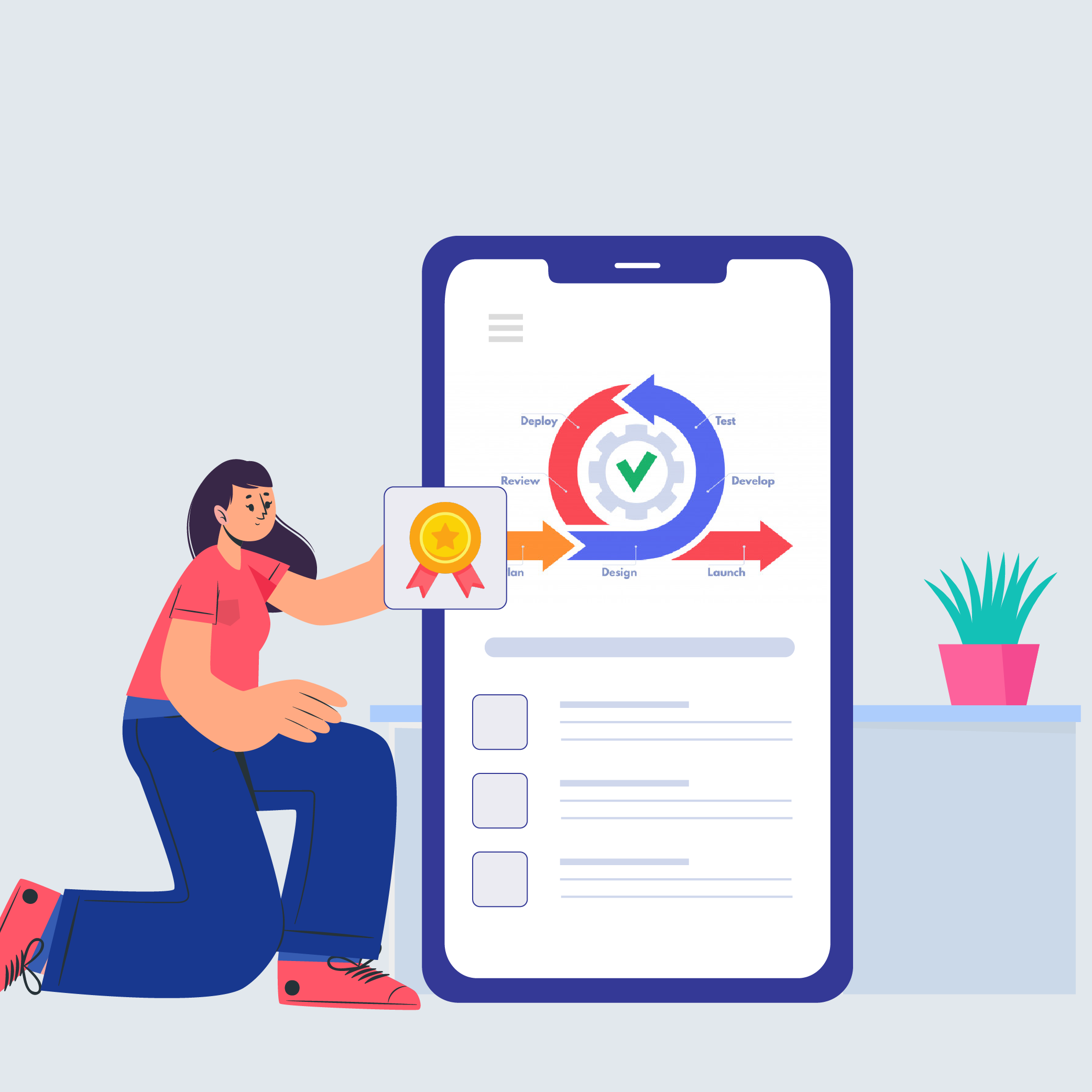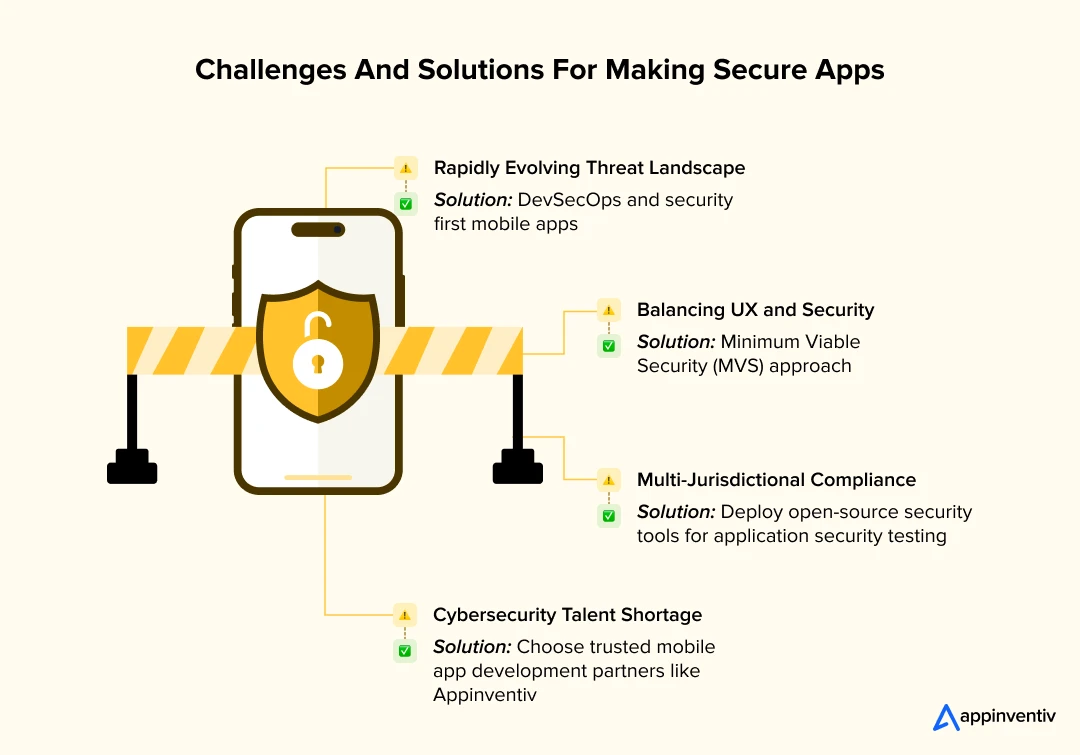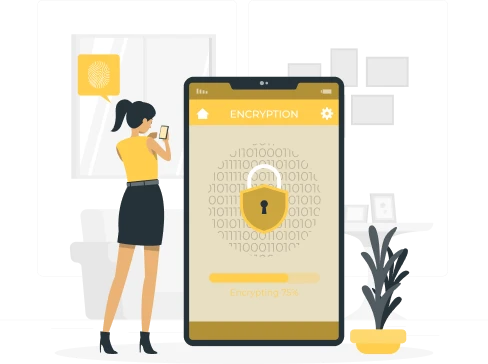- Navigating Australia's Regulatory Environment
- Privacy Act 1988 & Australian Privacy Principles (APPs)
- Cyber Security Bill 2024 (Cth)
- Consumer Data Right (CDR)
- The Essential Eight from ACSC
- Core Features for Ensuring App Security
- End-to-End Encryption
- Multi-Factor Authentication (MFA)
- Role-Based Access Control (RBAC)
- Secure APIs with Token-Based Authentication
- Encryption at Rest and In Transit
- Audit Logging and Monitoring
- Emerging Security Trends in Australia in 2025
- AI-Driven Threats and Defenses
- Cloud Security Enhancements
- DevOps Integration
- Software Supply Chain Security
- Post-Quantum Cryptography
- Application Security Posture Management (ASPM)
- How to build a secure app in Australia: Secure App Development Lifecycle in Australia
- Planning and Design: Security by Default
- Development: Secure Code Practices
- Testing: Identify Before Exploit
- Deployment: Hardened Environments
- Maintenance: Continuous Vigilance
- Cost Considerations for Secure App Development
- Basic Level Security ($5,000 - $20,000)
- Advanced Level Security ($20,000 - $100,000)
- Challenges in Building Secure Apps & Solutions
- Rapidly Evolving Threat Landscape
- Balancing UX and Security
- Multi-Jurisdictional Compliance
- Cybersecurity Talent Shortage
- Strategies to Mitigate Security Risks Effectively
- Adopt a Minimum Viable Security (MVS) Approach
- Use Trusted Open-Source Security Tools
- Automate Security Testing in CI/CD Pipelines
- Prioritise Regular Updates and Patch Management
- Train Your Development Teams on Security
- Appinventiv’s Proven Approach to Secure Mobile App Development in Australia
- Appinventiv’s Tailored Security Solutions: Elevating Trust in Healthcare and Fintech
- How Appinventiv in Australia Ensures Secure and Compliant App Development
- FAQs
In today’s hyper-connected world, mobile apps aren’t just conveniences; they are the baseline of modern business. From banking and healthcare to retail and government services, apps power our daily lives. But this digital revolution has a dangerous downside: cyberattacks are escalating alarmingly.
More than data exposure, this security breach costs businesses a lot, destroys customer trust, drains revenue, and tarnishes reputations overnight, and the numbers don’t lie.
- According to Queensland Govt, in 2023-24, the Australian Signals Directorate (ASD) recorded over 87,400 cybercrime reports, with identity fraud being the most common type.
- According to Information Age, 69% of Australian businesses experienced a ransomware attack in 2024, up from 56% in 2023.
How is it taking a toll on the financial side of the business?
- According to Security Brief Australia, 91% of Australian small business owners reveal that cybercrime costs them approximately AUD $300 million annually.
- According to the Australian Government Defence, the average cost per cybercrime report in 2022-23 was $97,200 for mid-sized businesses, $71,600 for large companies, and $46,000 for small businesses, a 14% overall increase from 2021-22.
The stakes have never been higher in Australia, where digital transformation is accelerating.
Recognizing this looming threat, the Australian government rolled out the Cyber Security Strategy 2023–2030, an ambitious, long-haul plan to turn Australia into a global powerhouse of cyber resilience. This means one thing for developers and businesses: security can no longer be an afterthought.
Whether you’re building a fintech app, a healthcare platform, or a government service portal, you’re not just shipping features; you’re handling people’s most sensitive data, and they expect you to treat it like gold.
This guide unpacks how to build mobile apps in Australia that are secure by design, from nailing compliance requirements to embedding strong security practices into your development lifecycle. We’ll break down the right tools, proven frameworks, and real-world tactics to help you develop apps that don’t just function, they earn trust.
Want to know if your app can withstand it? Request a Free App Security Assessment
Navigating Australia’s Regulatory Environment
To build a secure app in Australia, developers must move beyond technical protections and closely follow an expanding web of national cybersecurity and privacy laws. Australia has implemented some of the globe’s most progressive data security and cybersecurity legislation, so mobile apps in compliance with Australian regulations have become a crucial metric for trust and sustainability.
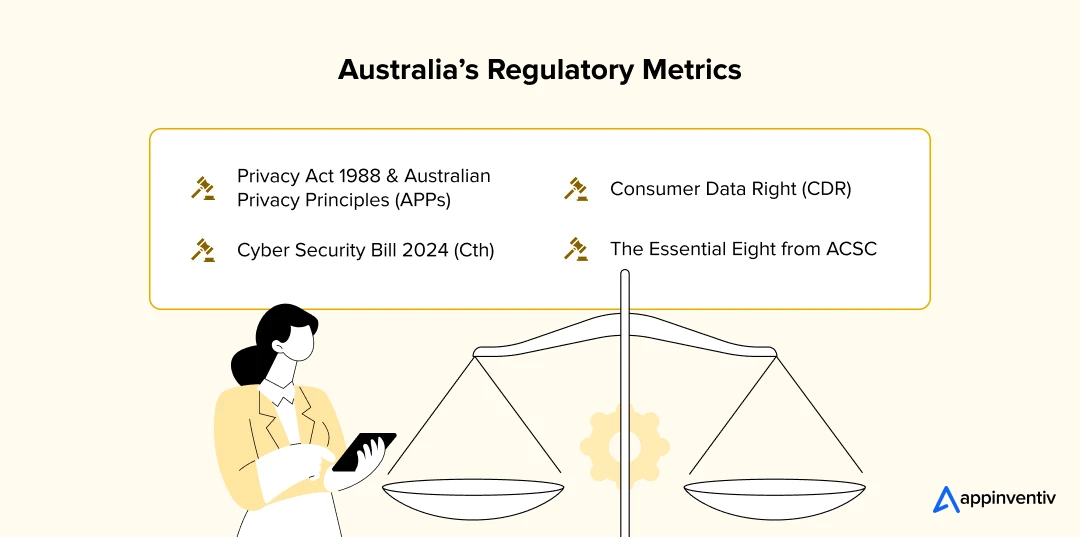
Privacy Act 1988 & Australian Privacy Principles (APPs)
At the core of mobile app security and compliance in Australia is the Privacy Act 1988. The Act and the 13 Australian Privacy Principles (APPs) govern the collection, handling, storage, and disclosure of personal information. For any mobile app that deals with user data, adherence to the APPs is not optional—it’s essential.
If your project involves real time tracking or transport based features, reviewing our insights on taxi booking app development in Australia can help you understand how privacy obligations impact system design.
Cyber Security Bill 2024 (Cth)
Presented as a component of the overall Australian Cyber Security Strategy 2023–2030, this bill defines a standalone framework for cybersecurity. It places requirements on critical infrastructure sectors and digital services, such as mobile applications, to establish proactive security strategies and be tested and monitored on a regular application security testing.
Consumer Data Right (CDR)
The CDR empowers consumers to share their data between service providers securely. Any developer looking to make a secure Australian app in banking, energy, or telecom industries must support data portability and safeguard consumer information with airtight encryption and access control.
The Essential Eight from ACSC
Instituted by the Australian Cyber Security Centre (ACSC), the Essential Eight measures aim to limit the possibility of cyber threats. They incorporate steps like application whitelisting, patch management, and multi-factor authentication, which are essential features in the application security framework in Australia.
Compliance Isn’t Optional
For companies and app developers, non-compliance can result in class action lawsuits, damage to reputation, and regulatory fines. The cost to make a secure app in Australia is far less than that of data breaches or fines. Therefore, incorporating compliance strategies for Australian businesses early in the app development process is not just a smart move—it’s necessary.
Incorporating these laws and frameworks early in your roadmap ensures you’re not just building functional apps, but designing secure Australian apps that meet the legal considerations for launching your mobile app.
Core Features for Ensuring App Security
Building a modern app isn’t just about user-friendly interfaces and performance; it’s about security, by default and design. To develop a secure app in Australia, your architecture must include a set of non-negotiable security-first features that protect sensitive data, enable compliance, and safeguard user trust.
Here are the essential secure app development features every Australian app should include:
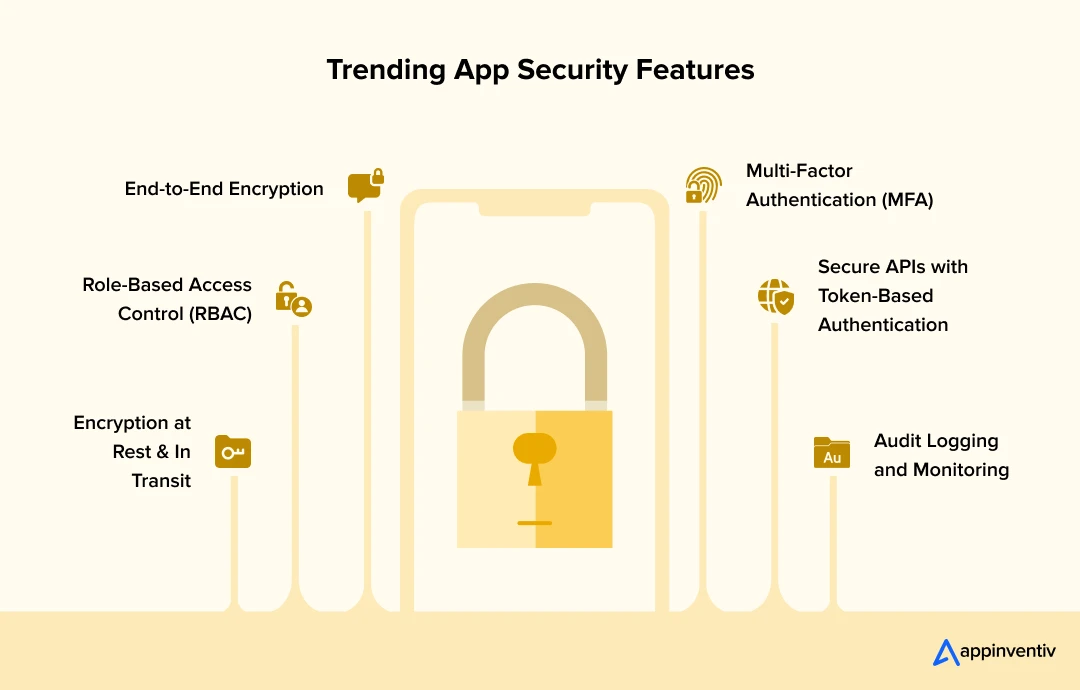
End-to-End Encryption
Encryption is the first line of defense for whatever you’re dealing with, whether login credentials, financial information, or health data. End-to-end encryption secures data in transit and at rest, rendering it unintelligible to all parties except the final recipient, even if intercepted.
Multi-Factor Authentication (MFA)
Adding more levels of identity verification is among the mobile app’s best practices to ensure safety and security. Businesses implement MFA, especially through biometrics like facial recognition or fingerprint verification, substantially reducing the risk of unauthorized access to user accounts.
Role-Based Access Control (RBAC)
RBAC ensures that users can only access parts of your app that they have permission to. This limits the exposure of sensitive information and is critical for industries with strict regulatory regimes, such as finance, health, and government services.
Secure APIs with Token-Based Authentication
APIs are common targets for attacks and must be proactively secured. Use HTTPS, OAuth 2.0, and access tokens to ensure APIs talk only to approved users and systems. This is especially important in apps that contain third-party integration or allow data sharing under the Consumer Data Right (CDR).
Encryption at Rest and In Transit
Data isn’t just vulnerable when it’s moving. It must also be encrypted when stored on devices or in the cloud. Incorporating both types of encryption helps design secure Australian apps that meet the requirements of the application security framework in Australia.
Audit Logging and Monitoring
Track all user actions and system activities with robust application security monitoring. Detailed logs can detect anomalies, support threat forensics, and help demonstrate compliance during audits. They also allow for faster incident response, minimising the impact of potential breaches.
Emerging Security Trends in Australia in 2025
As the digital world changes, so do the techniques and intentions of cyberattacks. Businesses also need to identify the components of building a secure app in Australia. Keeping pace with the latest security trends is no longer a choice—it’s mission-critical. In 2025, secure mobile app development is being redefined by five major shifts that are shaping the future of application security in Australia and globally.
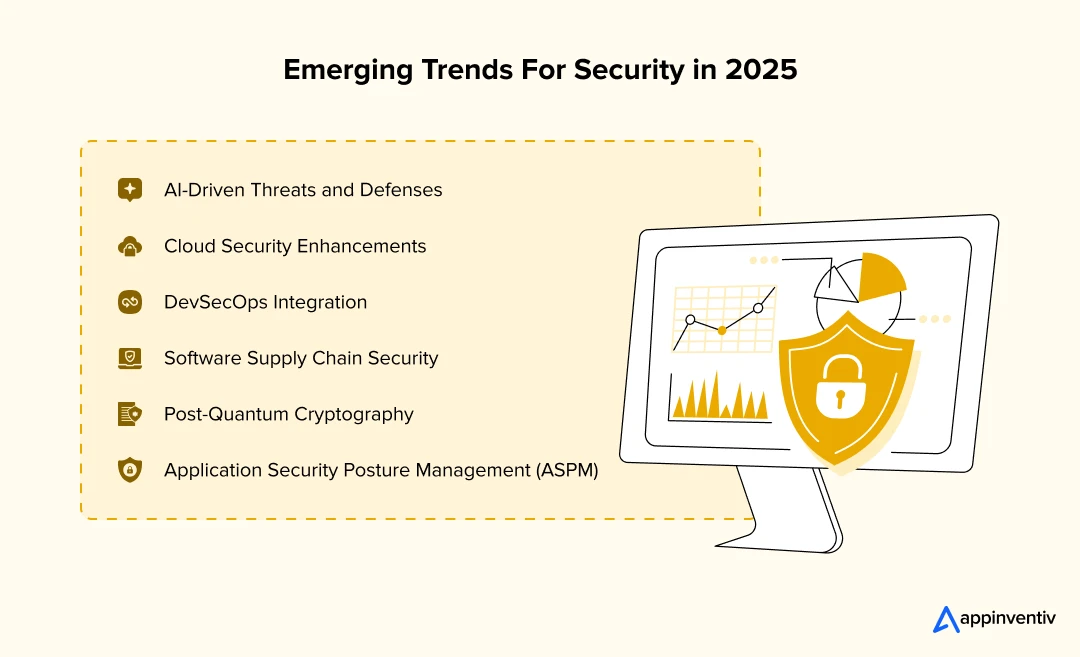
AI-Driven Threats and Defenses
The rise of AI-powered malware makes attacks faster, more targeted, and harder to detect. AI-based cybersecurity solutions are now being incorporated into mobile app platforms. They provide real-time threat detection and response, enabling developers and security teams to counter threats as they emerge actively.
If you seek to develop a secure app in Australia, adopting machine learning-based monitoring tools will be a standard practice for staying resilient in a constantly changing threat landscape.
Cloud Security Enhancements
With most mobile apps leveraging cloud backends, cloud security risk management is now essential. Cloud Security Posture Management (CSPM) tools continuously evaluate cloud environments for misconfigurations and policy violations. In parallel, the emphasis is rising on securing APIs and managing machine identities—key considerations for building mobile apps in compliance with Australian regulations.
For teams modernizing their cloud foundations, following a structured cloud migration strategy for enterprises in Australia helps ensure the app’s backend stays compliant and resilient.
DevOps Integration
Gone are the days when security was an end-of-line checklist. Now, devOps for businesses ensures security is built in from day one. This means ongoing security scanning, automated code analysis, and ahead-of-time compliance monitoring down the CI/CD pipeline. It’s a defining principle of secure app development in Australia, enabling speed and safety without compromise.
Software Supply Chain Security
Third-party dependencies are a major risk vector. In 2025, transparency and traceability through Software Bill of Materials (SBOMs) will be the focus. These documents list every software used in your app so developers can easily find and fix vulnerabilities. For teams aiming to design secure Australian apps, monitoring third-party components and supply chains is now a non-negotiable practice.
Post-Quantum Cryptography
Quantum computing, while still in its infancy, is a grave threat to classical encryption practices. Progressive developers, particularly those creating apps in finance, defence, or healthcare, are already using quantum-resistant algorithms to future-proof their systems.
Application Security Posture Management (ASPM)
Application Security Posture Management (ASPM) is a newer trend that is catching on in Australia. It enables developers to consolidate security information, compliance metrics, and risk indicators into a single dashboard, making decisions faster and reducing blind spots.
Also Read: Top 40 Startup Business Ideas To Launch In Australia in 2025
How to build a secure app in Australia: Secure App Development Lifecycle in Australia
To build a secure app in Australia, security must be woven into each application development life cycle stage, not added as an afterthought. It’s not merely a matter of code, but of mindset, governance, and strategy for the long term. Here’s how to build a secure app in Australia, step by step:
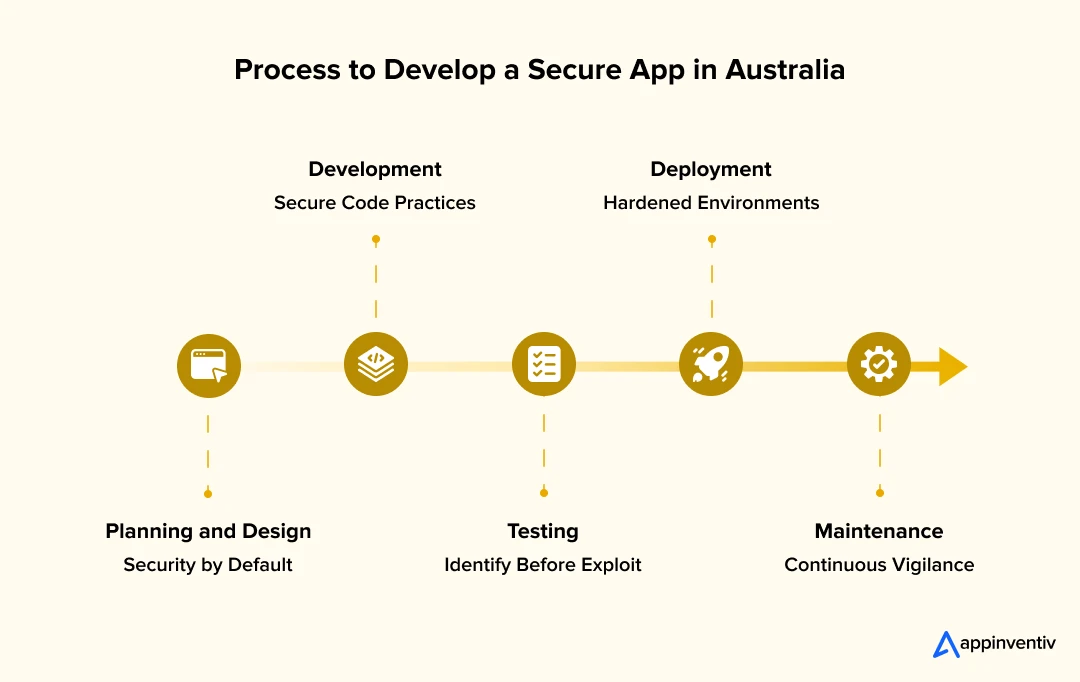
Planning and Design: Security by Default
Security begins at the whiteboard. At the planning stage, architects and developers must include security requirements, such as threat modelling, data protection policies, and adherence to legislation such as the Privacy Act 1988 and Cyber Security Bill 2024. This initial step will secure user data in app development.
Development: Secure Code Practices
Vulnerabilities often creep in during the development stage. To prevent injection attacks, security-vetted frameworks and libraries must be used, and role-based access control (RBAC) and input validation must be implemented. Practice secure coding techniques, peer review, and minimize third-party dependency.
Testing: Identify Before Exploit
Testing isn’t a one-time task—it’s a continuous defence layer. Use static and dynamic application security testing (SAST and DAST), conduct regular penetration testing, and leverage specialised solutions that align with your compliance strategies for Australian businesses. This phase is critical for regulated industries to ensure the app meets all required security standards before deployment.
Deployment: Hardened Environments
Once the app is ready to go live, it needs to be deployed with security settings in place. This comprises API token encryption, HTTPS enforcement, multi-factor authentication (MFA), and securely managing secrets. Whether cloud or on-prem, ensure the infrastructure complies with the application security framework in Australia.
Maintenance: Continuous Vigilance
Security doesn’t end at launch. Your team must implement application security monitoring, release regular patches, manage updates, and monitor for zero-day vulnerabilities. This is especially vital when aiming to keep mobile apps in compliance with Australian regulations over time.
Don’t screw your users or tank your rep. Build a bulletproof, compliance-ready app with Appinventiv.
Cost Considerations for Secure App Development
Cost is often a key concern regarding secure app development in Australia. Although security may appear to be an additional expense initially, the long-term benefits of building secure apps in Australia—protection against data breaches, compliance with the law, and continued user trust—greatly exceed the investment.
The cost to make a secure app in Australia ranges from $5,000 to $100,000 (AUD 7800 to AUD 1,54,000). The cost considerations for secure app development are divided into Basic and Advanced security levels. Each level addresses different needs, complexities, and budgets, helping businesses make informed decisions.
Basic Level Security ($5,000 – $20,000)
Basic level security is for small-scale applications with minimal sensitive data, such as personal productivity apps or informational platforms.
| Key Components | Costs |
|---|---|
| Secure Coding Practices | $1,000 – $3,000 |
| Basic Authentication | $1,500 – $4,000 |
| SSL/TLS Encryption | $500 – $1,500 |
| Basic Vulnerability Scanning | $1,000 – $3,500 |
| Compliance with Basic Standards | $1,000 – $4,000 |
Factors Affecting Basic Level Costing
Conforming to frameworks like the Australian Privacy Principles, CDR, and application security testing requires legal audits, reviews, and, in some cases, certification. Basic security measures are affordable, but higher-level protections and compliance checks increase costs.
| Factors | Cost Impact |
|---|---|
| App Complexity | Low ($500 – $2,000) |
| Third-Party Tools | Medium ($1,000 – $3,000) |
| Team Expertise | Medium ($1,000 – $4,000) |
Advanced Level Security ($20,000 – $100,000)
Strong security is important in complex fintech, healthcare, and e-commerce apps. Data leaks in these fields can have serious consequences. This protection relies on tough measures to stop major threats and follow legal rules.
| Key Components | Cost |
|---|---|
| Threat Modeling and Risk Assessment | $5,000 – $15,000 |
| Advanced Authentication and Authorization | $5,000 – $20,000 |
| End-to-End Encryption | $3,000 – $10,000 |
| Penetration Testing | $5,000 – $25,000 |
| Secure DevOps (SecDevOps) | $5,000 – $20,000 |
| Regulatory Compliance | $10,000 – $30,000 |
Factors Influencing Advanced Security Costs
The table below highlights important factors influencing the costs of implementing high-level security in app development. This is relevant to building complex apps that need strong protection. It provides details for each factor and shows the estimated cost.
| Factors | Cost Impact |
|---|---|
| App Scale | High ($10,000 – $30,000) |
| Regulatory Requirements | Very High ($15,000 – $40,000) |
| Custom Security Solutions | High ($8,000 – $25,000) |
| Ongoing Maintenance | Medium ($5,000 – $20,000) |
Note: Application security monitoring, patch management, and vulnerability scans are continuous responsibilities that require budget allocation after launch.
Also Read: How much does it cost to create an app in Australia in 2025? A detailed guide
Hiring or engaging the services of cybersecurity professionals—preferably ones with experience using the application security framework in Australia—means that best practices are infused right from the beginning.
Hiring cybersecurity professionals that can offer you a Cybersecurity Strategy for your business in Australia ensures best practices are implemented from the start, especially when aligned with the country’s application security framework.
Ultimately, the cost of making a secure app in Australia is determined by its complexity, data sensitivity, and industry-specific regulatory compliance requirements. However, security is always an expense that cannot be cut when reputation and user data are at stake.
Challenges in Building Secure Apps & Solutions
As the demand for secure mobile app development in Australia grows, so do the challenges. Addressing these head-on is key to building reliable, regulation-ready apps.
Rapidly Evolving Threat Landscape
Cyber attackers constantly refine their methods. New attack vectors—particularly those powered by AI—require developers to implement adaptive defences.
Solution: This is where real-time threat detection, DevSecOps, and security-first mobile apps play vital roles.
Balancing UX and Security
Users want frictionless experiences, but security often introduces layers—think MFA, permissions, and encryption. The challenge is to design secure Australian apps without compromising performance or usability.
Solutions: Leverage a Minimum Viable Security (MVS) approach that ensures essential protections.
Multi-Jurisdictional Compliance
For companies targeting local and international markets, aligning with mobile app security and compliance in Australia and GDPR or HIPAA can be tricky. Having a flexible, modular approach to compliance helps meet diverse security challenges specific to mobile apps.
Solutions: Leveraging trusted open-source security tools for application security testing.
Cybersecurity Talent Shortage
Australia lacks skilled cybersecurity workers because there are not enough professionals to handle the rising need for securing digital systems like mobile apps. As online attacks become more advanced, businesses need people who can plan, build, and manage strong security solutions. To close this gap, many businesses turn to outside help or invest resources in training their teams.
Solution: To bridge the gap, many businesses rely on trusted partners like Appinventiv for mobile application development services that already embed security-first capabilities and regulatory alignment.
Strategies to Mitigate Security Risks Effectively
Security is no longer reactive—it’s a proactive discipline embedded into every stage of development. If you aim to make a secure Australian app, it’s essential to adopt strategies that reduce vulnerabilities before they become threats.
Here are proven approaches to minimise risks and uphold strong mobile app security in 2025:
Adopt a Minimum Viable Security (MVS) Approach
Much like building an MVP, the Minimum Viable Security model ensures that essential protections are in place from day one. By identifying baseline security requirements and gradually scaling protections, teams can develop secure apps in Australia without stalling innovation or go-to-market timelines.
Use Trusted Open-Source Security Tools
Open-source doesn’t mean insecure. Many vetted tools are widely trusted for application security testing, encryption, and vulnerability scanning. Leveraging these tools within your stack keeps costs in check while strengthening your app’s defences.
Automate Security Testing in CI/CD Pipelines
Integrating security into your DevOps workflow—known as DevSecOps—ensures continuous risk mitigation. Automated scans, code reviews, and policy checks embedded in your CI/CD pipeline can identify and resolve threats early, reducing last-minute production issues.
Prioritise Regular Updates and Patch Management
Cyber threats evolve, and so should your app. One of the most overlooked components of building a secure app in Australia is timely patching. Whether it’s a vulnerability in your codebase or third-party components, consistent updates are critical to protecting user data and staying compliant with Australian regulations.
Train Your Development Teams on Security
Often, security breaches stem not from code but from oversight. Conducting security awareness training equips developers to write secure code, recognise red flags, and understand emerging threats. This cultural shift is essential to maintaining security-first mobile apps.
Appinventiv builds bulletproof, scalable apps with full-on protection. Grab your quote for hardcore security!
Appinventiv’s Proven Approach to Secure Mobile App Development in Australia
If you’re looking for dependable app developers in Australia, Appinventiv leads with a security-first mindset. Unlike traditional development partners, we embed protection at every phase, from concept to launch, ensuring our solutions are built to withstand modern-day threats.
With strong domain expertise in highly regulated sectors like healthcare and fintech, our approach to secure mobile app development in Australia combines technical excellence with full-spectrum compliance.
Key Pillars of Our Secure Development Approach
- Advanced Security Protocols: Our development foundation includes end-to-end encryption, secure APIs, multi-factor authentication (MFA), and real-time threat detection, ensuring data stays protected, even in high-risk environments.
- Compliance-Ready Architecture: We build apps that meet rigorous local and global compliance standards, such as the Australian Privacy Principles (APPs), GDPR, HIPAA, PCI-DSS, and ISO 27001. This ensures that your app is ready for audits from day one.
- Regular Audits & Updates: Security doesn’t end at launch. Our teams conduct continuous application security testing, regular vulnerability assessments, and efficient patch rollouts to stay ahead of evolving cyber threats.
- Emerging Tech Integration: By harnessing AI/ML for threat prediction and blockchain for secure, traceable data handling, we take a futuristic stance on app protection, future-proofing your digital assets. and elevating your digital transformation journey in Australia.
- Agile Development with Compliance at the Core: We follow rapid, iterative cycles that prioritize feature delivery without compromising security. Our method ensures you meet critical compliance strategies for Australian businesses while staying lean and innovative.
Appinventiv’s Tailored Security Solutions: Elevating Trust in Healthcare and Fintech
Healthcare App Security & Compliance
In healthcare, apps carry more than just data; they have lives. With rising cyber threats and stringent regulations, mobile app security is non-negotiable. Appinventiv designs healthcare solutions beyond functionality, embedding security and compliance at every layer.
Fintech App Security & Compliance
In fintech, security isn’t a feature; it’s the foundation. Every interaction involves sensitive user data and financial transactions. Appinventiv builds fintech apps that strike the perfect balance between regulatory compliance and seamless user experience.
How Appinventiv in Australia Ensures Secure and Compliant App Development
Comprehensive Security Integration
At Appinventiv, security isn’t an afterthought—it’s architected into every layer. Our cybersecurity-first approach ensures apps are resilient from day one.
- Code & Architecture Risk Analysis: We conduct rigorous application security assessments to identify and address vulnerabilities across codebases and system architecture before they become liabilities.
- Vulnerability & Penetration Testing (VAPT): Our VAPT protocols proactively uncover weaknesses by simulating real-world attacks, giving you confidence that you are one step ahead of emerging threats.
- Cloud Security Reinforcement: Whether AWS, Azure, or multi-cloud setups, we harden your cloud posture with robust access controls, end-to-end encryption, and real-time compliance checks.
Adherence to Australian Regulations
- Governance, Risk, and Compliance (GRC) Integration: We implement strong governance models and align with leading compliance standards, so your app is audit-ready—always.
- Privacy-First Architecture: Built around the Australian Privacy Principles (APPs), our apps ensure lawful data handling, transparency, and user consent as defaults, not exceptions.
- Aligned with ACSC’s Essential Eight: From MFA and patching to macro controls and whitelisting, our security playbook reflects the ACSC’s most critical mitigation strategies.
Continuous Monitoring and Improvement
- Managed Security Services: We don’t just build secure apps—we guard them 24/7. Our managed services provide ongoing protection, monitoring, and incident readiness.
- Real-Time Audits & Compliance Reporting: Get complete visibility with continuous audits, intelligent logging, and dashboards that make risk tracking and compliance reporting seamless.
- Rapid Response & Recovery: Our incident response plans are designed for speed and precision, minimising disruption, containing threats, and preserving trust.
Integration of Emerging Technologies
When you hire mobile app developers in Australia, you can expect innovation seamlessly combined with security. At Appinventiv, our experts leverage cutting-edge technologies like AI and machine learning to proactively detect anomalies and automate real-time threat responses, minimizing human error and accelerating response times.
Meanwhile, blockchain technology adds an unbreakable layer of trust, securing transaction records and ensuring transparent, tamper-proof data trails. This forward-thinking approach empowers our clients to develop secure apps in Australia that aren’t just compliant, scalable, and audit-ready from the ground up.
FAQs
Q. How to build a secure app in Australia?
A. Start with secure design, enforce strong authentication, follow ACSC and OWASP guidelines, and run frequent penetration tests.
Q. What are the challenges in secure app development in Australia—and their solutions?
A. Challenges include navigating complex regulations, keeping up with evolving threats, and protecting user data. Solutions: embed DevSecOps early, adopt compliance-driven design, and use automated security testing.
Q. What security standards are required for mobile apps in Australia?
A. The ACSC Essential Eight, ISO 27001, and industry-specific guidelines (e.g. APRA for finance) are critical, along with the Privacy Act and CDR compliance.
Q. What are the most common security threats for Australian apps?
A. Data breaches, weak authentication, API vulnerabilities, malware, and misconfigured cloud services are top risks.
Q. Can Appinventiv help audit or build secure apps for regulated industries?
A. Yes. Appinventiv Australia specialises in secure app development and auditing for industries like fintech, healthcare, and government.
Q. What tools or frameworks are recommended for app security in Australia in 2025?
A. Recommended tools include OWASP MASVS, Snyk, Veracode, Prisma Cloud, ZAP, and frameworks like ACSC Essential Eight and DevSecOps pipelines.


- In just 2 mins you will get a response
- Your idea is 100% protected by our Non Disclosure Agreement.
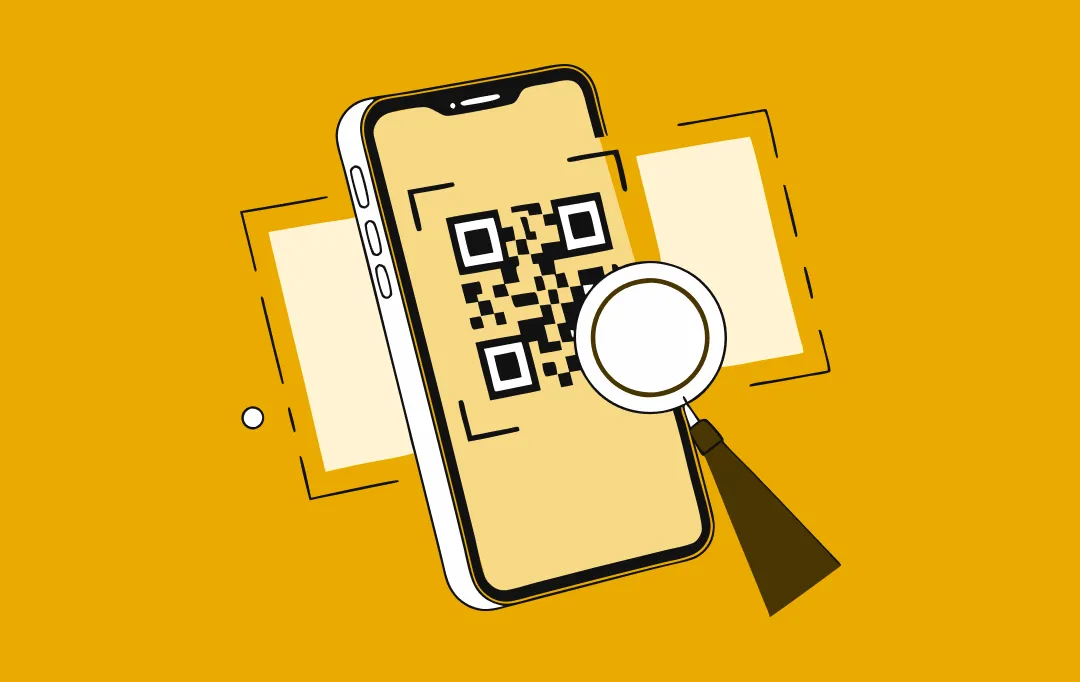
How To Build A Product Scanner App Like Yuka – Explore Features, Cost, Case Studies
Key takeaways: A basic Yuka-style product scanner costs between $40,000 and $80,000, while advanced builds with AI and large databases can reach $400,000 or more. The real work is not scanning barcodes, but managing accurate ingredient data, scoring logic, and compliance with FDA and CCPA rules in the US. Successful apps begin with core features…

How Much Does It Cost to Build a Ticket Booking App like Ticketmaster?
Key takeaways: You'll need anywhere from $40,000 for a basic MVP to over $400,000 for an enterprise-grade solution if you're looking to build an app like Ticketmaster. Want interactive seat maps? Maybe AI recommendations? These features are great, but they'll definitely push your costs up. Here's where you can save some money. Asian developers charge…

Unlocking the Cost of Building a Community Platform Like Qatar Living: What to Expect
Key takeaways: Building a community platform is a business decision first and a technology project second. A strong MVP in Qatar typically starts around QAR 109,200–QAR 254,800, while full-scale platforms move into the QAR 2,184,000+ range based on scale and ambition. Success comes from solving daily user problems, not from copying features. Cost is driven…








